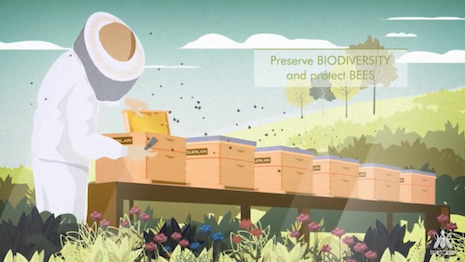French perfumer Guerlain is building awareness of the plight faced by its brand motif, the bee, through a long-term plan to protect biodiversity.
On the heels of the European Commission’s Green Week, Guerlain shared its future plans and ongoing commitment across social media to ensure that its consumers are aware of its corporate social responsibility efforts. Luxury has seen a recent spike in environmentally friendly causes, but only efforts with a clear tie to the involved brand will read as authentic among consumers.
"In growing numbers, people want to work for and buy from companies that share their values," said Andrew Winston, strategy consultant and author of The Big Pivot and Green to Gold. "Authenticity is a core pathway to explaining your values as a business and 'walking the walk' on your principles.
"In this case, where bees are part of the imagery of the brand, it makes a great deal of sense for the company to tackle this critical global issue," he said. "The threat to bees is a threat to our food system and to the supply of ingredients for personal care products, including those I presume Guerlain makes.
"It's a logical connection and ties to their sustainability as a business."
Mr. Winston is not affiliated with Guerlain, but agreed to comment as an industry expert. Guerlain was reached for comment.
Beauty is buzzing
While vital for agriculture, the declining bee population has proved detrimental to flower fields. As a traditional perfumer, which relies on sourcing the world’s best ingredients, Guerlain is deeply invested in ensuring the world’s bee population can bounce back from the brink.
Using social media, Guerlain shared its efforts with its consumers to build awareness about the importance of bees and what the LVMH-owned brand is doing to assist the cause.

Guerlain's efforts promote professional beekeeping. Image credit: Guerlain
To show its long-term dedication, Guerlain mentioned that this year marks the 10th anniversary of its sustainable development initiative “In the name of beauty.”
Additionally, Guerlain has worked with the Brittany Black Bee Conservatory since 2011 to protect biodiversity. The perfumer has also worked with the French Apidology Observatory since 2015 to develop hives and promote beekeeping in Europe.
In a debut series of videos dubbed “Bees Universities,” Guerlain spoke with Laurent Boillot, president of Maison Guerlain, apidologists, biodiversity experts and sustainability advisors to the United Nations about the importance of protecting bees.
Each interview tackled a different topic about how bees work and why they are essential to not just the future of perfume-making, but humanity's future.
Universités des Abeilles / Bees Universities - Laurent Boillot - Guerlain
In an animated effort, Guerlain outlines its 10-year sustainability commitment. The animation begins with a beekeeper checking on a hive and follows a single bee as it flies through Guerlain’s factories while text explains the brand’s efforts.
Guerlain plans to build long-term partnerships and sustainable procurement, develop eco-responsibility sites, control CO2 emissions and leverage eco-designs for its packaging.
For example, when a consumer purchases a Guerlain fragrance from a Guerlain Parfumeur depuis 1828 boutique, and selects the iconic honeycomb bee bottle, the vessel can be refilled at the store’s fragrance fountains. Guerlain’s refillment offer does not expire, creating a service that is both luxury and sustainable (see story).
10 years of sustainable commitment - Guerlain
Bee authentic
Since 1853, Guerlain has used the bee as its “symbol par excellence.” The motif has been used to inspire creations, and is incorporated on Guerlain’s most-precious bottles and is the primary element of the perfumer’s sustainable commitments.
In 2014, Guerlain commemorated the 160th anniversary of its Bee fragrance bottle with an exhibit featuring nine art pieces inspired by the bottle housed in its boutique at 68 Champs-Élysées.
Guerlain allowed its fans around the world the opportunity to experience the exhibit, titled “Nect’Art,” digitally by posting features on each of the artists to its Facebook page. By hosting this event, Guerlain was able to showcase its heritage and the company today, and grow its audience (see story).
Also, Guerlain selected the classic crystal decanter with engraved bees, a design dating back to 1853, to be the focal point of an artistic collaboration with artist JonOne.
The bottle, one of Guerlain’s most recognizable, was intensified by JonOne’s street-art style and his signature splattered technique (see story).
With many brands choosing a cause to align with, only those that have a strong relationship to the brand and its house codes will be embraced by consumers. Anything short of authentic will be perceived by most affluent consumers as a marketing ploy.
"In this case specifically, the company says they rely on ingredients that bees are critical to," strategy consultant Mr. Winston said. "So it's a business viability and resilience issue. In more general terms, brands should 'get involved' with environmental and social issues because it's good for their business.
"They can lower costs and risk, drive innovation and build their brand value," he said. "The 'environment' is another word for the resources that support our entire economy and society -- clean air and water, abundant fiber and food, metals and other natural substances and much more. So of course companies should get involved."
{"ct":"w0A6iqOMP5haOLXPhUyBISf\/aL8LH\/FjqayvD8zIHKlYM7lUfp9F6PlAJjIbSZU4jVANWjb0EqpEha0MkdH3jsD840\/CQYSpEplQ1hISyMHK40esUm2JTf3hgKQEVGTPQ458Jst+g0xMg1BImMosJF8Kv6DYUjE+3GMwL+yhoPiQCSpXgJ7Yww2gzJ2BG\/50zYjxly+MM28ZFxemP05P4oyWdKJCM1\/EoTf2+7zWcfByB77O3aKsk\/\/QeSNdRfv21u9Jc2J4nEOGa6suNkZnrFK0o8HfNEu36DbPL0PrsOa8frQTDQZ7utH2BJsB3g3aRfAwPVCLTlrsCgiYccQNszKlZrz5cHWSMQFNGx5IUWYHDz9FJx64xeje0B469Rw5U5Tx49hUJ909LRbEwW2Z1YeK7dvGu6TWGd59D7YZS3u8t9amVBnhyksYXC7Eqlm0m5Hn\/JxYiQ4N3h5hyQocHjYIme375Rv\/sWAzWisVJXdvU4x4yXDfK6pkBFe3vq1BaLU8dW8SKMrFMIOWo5VRxEgyXcQqzKMNSWrN\/n2rjiYrdtwwCvSjJgCcpjIdU8T3u6xWSXe+HX7Ybzb5hQgWGs7qyeOEGOMxZQQHzEWhM9mbHnu7Bo62StHwfmacoKVuUyVQfHxpkaVxngQOK97eiyciSevbg\/TFM3trfF2eImsw8xj6RCAMs4i8\/CKrFhKYc7v2Mb7KS\/pCbe7nOPhybh27OwdFn3BGcWQCb20jEjxGSiwNSSeAYdWPNtpA2ucndYFwsNSic9NyezSFErf0gzr5C+IywhSBhJkeY582Rq9SqqpimbYtuqIxq0vCIDaIvSj0kL+Kwregxth0s\/\/VPIejM2RLDZfOQyTsOWgmEgpn+CeF24PRVT6Bbx4HISNXRIBvIg\/ZvNwORvimd6k9WJMbVYx3ooz4HnoznjOdTMYKAcZ88tOPjqyXpfCMmrrmH3lDSVOqIFijfsnmim9trdz6VW7vM4RRCEcrjUPrANpZv8FjexicKfT4zZXMjuoKb\/qnBpIwA6\/vxddhJzRFiJQcT18sHR6bMX6GRVozaTPjtfth\/LzN8Xs03rMRXC+5fCzc+QU6832y+NOnkNPlW1UQ1ie9jSoPHH9qJdVaR1fUrdls8efyJLhvV9giQrnVeFkbd8crpFJ\/CbGNYNOgdz+xbCyBz9Mi12E74V96ZqSQy7ixMzglOEYeYSPYxrkuHd\/uY6SVDoPiUVdYodT9cNufEvS9N78w8kxAzJKvXLAXNcUzJVL7iZcPoaABD74h+hUJJZmQJsnOFuVJOJzpCvS\/G95iZJXkn3KqeIjh9i3zOCjQQNPHM09E0H0Ig5B0ttliJfrmgjhsCUiEH5pnJoccVL8qugETu+tCle2QzBLKunHuxAcNYNUkwWCXYTfSLbkrPui25SnGZTj3tks0Y1\/xeikIavRetqt15pOFIo8G4ge0nUqh1Rtz\/Jcfmb9gNKFK7\/8DB+yTmzAErkLK99aqY+JvulYIyurWEODctHDxD2WoQ24HaolaxBGObjoWf3PP0xWhlQkTvCHc6Vc5Tf6PnthCCyFDbDiwfLOMBJTNmPbeUj9xPlLQ7HLkBGWju+DPdLiF0j7z6BxisNgw5NDkIJ8zcNY6iZ+T907I17r2vVNrg3GJXQLY6u2DHzC94O1cHuFQamScBHBkqXs2vRK1lI7e4oHOjaYdWscgKiZo1OKhozJMV\/pBqeOKEV+X7+wzNf4q2BHk99tUDWQSjlmfK\/nfMUW3NqMZbQJ+eAFIfvHxjf0UBCYT07hkfLIG0OYED1c6Eb9MrZK6ZyU3dGnhxvgor6mgevlHm5J8mKICEFN0wgXbQwR0T1uBlD6yzZ9JifP9I\/h48Lpy88\/nXa897c3i5dYmJQntplrtI\/p3PbVmaQQJaE7f3vGV5hfQNpEwcHuuYDD0rYYQE6VgP90CvjS3OpbDcKAhuV+OJ5znnw6SwzyKtDGQyzsh0aunWeL1DmlkGw6\/90YuOtRP24cxUj8zQqx7vZY+hX+y6srM16oy0fJA3g5r0waQVwN0Pw3z5NR2aZjewn18lh2a\/j6TNlyjZL3OR\/M5Y37BqfOV7CTeGq7ZQpsDdezVliJc4ZxCePcyRNqzL9fVrcw7fEacH8BeCrUiNsFpxj9PtUMI0YtcP43KFaIwmMiP1JRDa\/0f51iaBHPzQqM1ws8O3+sYb8USeCswx3W9CbsJvf2GXa\/4fEKt10SNNYfBNtiPV8ELemeEAkdXSvd5mMNtxxbAGoJpsv8xj7mI\/ctnTmswsZHrlk+jhN7JsGwoCENqn+JLqwkv76dFzSjjpbdPhLN\/LNlQou2FHVJVNyZ8V24Z2eH4LqbOq440vJnQpp2bz7QO2ZGhu22k8f4qeZWi9O+0K\/aIblRifFa123e3XZO\/U7lIKviYNjAeuBR7pzJVMIVwD53ce4GNqgkQVSedHfSc3fnVvp9iV6+PiWaHl+xxbOVfKqjmnxH\/rUbJUUuunHsLiW4h5E1oO2KZ4zVZXpgHbq8oHv\/sxnl\/JuKOCvN8BTnEwOqJg39mnpU\/OmuxeV7+3i\/gi\/gwLWm0FSIJxv11wqXSO5wB+z+5gz4AOMR7Upmf8+fhDRvSVOTwkvehyomfrGuX6n1qEdGLgTOxCBiZf4y0ilmg+diytLiFDY8CmkMdjqeWTkETL8ZCtCo3Y98S8it7igvfs9VuvZfpIYmFEnw+wdpigzIF\/NLxDbQIAYVt9lCwgTvqbE1JdZlIHSSmn\/SQS3aPZ0eotEpjSPTpk69lH7QvJ5XcdkX+i06wlj2zjrpNXawBpDOOhRYXQpvuu2JuG+rOrKvRFU2E6Zhy0COtRROEKotk2etilOsKmK+4ohWkYEcYVRkTFuXbYZyLtRTWmHHsPG\/gurbgsGJ8vBLw8y4vDEJHgbkGgyZ5P3CAOhKPkyuEF6mxegXHawpZ90o10L7bVm43D+242ZatNk0hj2e+PwCqO9MD4MSwxPSqZsSkHgkA7jj3H363JZDvRJ73r6ZiiNA7FLgWgB\/eTVmzJxvbtTUo2NzYLDxtB5ymRC1wHqcH6wRt1cKpZwZFbYohLLbrCm\/tXnD0B2bYG\/aYPFQNPb02w0GmHT\/c4wyylm8rTxunKVZtiMD5Ugme4b9hD6wP98PmACRbT+rfO\/ihAT\/cqYMasi1FSIfP\/6cwJGTxS9ywXg2z6ngVVWRlZlRxpeDibfu\/8c+Z36T68pGQaYiudZu7+qkk7cJ2AscJycF0XWpUm3Iihj9Y0D49q72nnwISQxJ\/WFrg+nxjzSXdO1thF1vawDJqQQ7cZiuoLYVDHdaRQq++dAq3eJW2iTBypbiKsCSGU7X7ry8YnBb2KtwAQ8A15xsaPl0aGsNVaHwWG\/l920dkE4zsuaUrLsuBHwW9li6PeJzF\/l1\/QxJdLEqFGghxt+sjYJFii7gIBNj+uQsB2P7npkWKBwl8eb54EwxXVDMjlAHfX82L1aNo4T\/HOSxJEwV\/dm\/mVNtGZp3RY9xqhSQWAzURGT+0tIh2PP+dPexp3uk1Z+9ysHYQkwYrekM+phiQ8ihFlzBkwsssBm177AdnZyTUv+Ja9hFlk\/yao3MEgaJ4V6TryBqO4SaR+8YfviZ0qfBA01pvSyYGnccQR8977yvjRLsrBbPeHs3da2WDK4NtxiR64fpEgbQwcUlldnQfrLc7274s4Nmq8gqwQbexZaPFUEIT++1pRBH+\/yurrHgbe+G1xDVYZe08J4\/AxCJGSRSHmvFlglJe9ARSZfLbjc7IbBlzMgntH0GSPJYAMKkkS8NYUWoBaw6G\/Ubh1Xo+kNefUB5cPKKjMb5P2ZN8jewLuOlECT2gqa8fp8VRpB4p3d9eH\/AwCn9ZZTpJwOnPKNazlCBkXu2H9Qpw7rXT13BaM\/3aXgT6umZjVbPLEZGVCoQiGhLec7cWoDrbPpyE6w1ES7wmyHeFOYPB+jWFzIbLiCEFd0KdpaqWb6GArULZX34pMEs4J8IscgOXElA6Cgw910I3Nx15rCeWkcm2nLNEAFROhvKR9e7PTpyiB+7SQPLKVubM4ZrG+J8hP\/qBQeydVanwVMDfNETuLcjrFTBZb7oONERSi3kd+7cdmdyLMMPe8VtFMzk18bSxajAwJlGddBbalRWh2925apWTH5CQf9NMgOLrP1VQU5TRgR+7zTERvXOJBleVx\/wH2ANVkfRLGPEirSV\/qcgS0yULVKIvHY34NQhGe8x7eTSE18SWl0m2Yj\/Q\/lArH64vXMunFFoBea48Qoq8TtPcNlek8PowlC0SOvUQ9vZWucXiDbGdPGK+e0jRg\/61M0DjCT8u7G02eUWl+pd3hHLZUHBuS2xUg\/QWSHn2\/z52MiINbBsm+L5etG\/etnN5PVCtygh4D8c\/DI7TcvndxUY\/JCQIFSVTYurIloK2nC4dbOlsNfU8Lapg2RwauYP8jIzKKdivfvz+4S0Y5jfLaRYR6T5IcIpzthord6UwTNO36UnocGT1A7QG17VdVaqvwho0YMZhsHzr3EamOp48\/Lu6k86m0wQZxT29xTa6VjROWcyfBEGQJCLfYBq975+f4OR44ztNBlCEfyH5abrcjAbw6Vcboki0FIDKkKYyUSN\/2p3auMNnnevoEixH5PgdDP2WyVlttgAxHoAlOrgJ3dYuFNT3KdIjdrUezuOFaUJtr7p7H3kp3FDAbwEwQTJ4OruaJlWeWwnqAgvrmtDPBdvTQGNn1x018vq3m0zNYud9kIkkjUeZKNXR1sedaq4B8tr4OCLxF81rv1kwxiGK231TLs\/Ve9bBek6VmINyGO\/dvKdihvqrRlAVbedfYsHMzlkmEX4iGAQJPT\/3s0Q7TAWFsYVxlPKeEN3NXyDeizBZS7bVqfW60MCM9oR72ciKunDuG4\/+eKQ43hzrCVtQ75QfUvsj5EfqcQaza7j7XdViWeL4ZXpIKUrVr84Kf\/Tk0uWWOZ830\/gArtOORzVsjHtEAZ2Lkq8lVKfDFcUbBrZa9waenJiBerqaVjKGqMJn9E21O3TpYnBDP0j\/izn8iX0H7o3\/W81PQV\/7h1N9fWBbY5ZikqMujfSRZZvN2E4LJL3PZtvLkY7AxXSOTJfisV7xq2LKrXoIvtoAWLw3Ywlt69ZWrABylB7lDSmM1JEh9z5AActs6wLQTiYuKHkJYVTAhty2QQHalkr0MvXzVwRI+2ODuluuuFG4tVn\/3TclpLM67HzXqEHbMcRTNJmDRfVvwinqKf1NkakxmWoRvHUFFWfjHgqO0hWeVRTy+PnITjLh3Cm\/hROmjXxQ7QkMv9m2sp+RBZmesnmvnGR8a9UpkXGPS\/8ZT96LRGx228a9\/UBsq0aFfoiP9v71dwdJSmZiIRAfQKbUxaW3gqhVqIJ1rukSBlbwKvuse43GKKxVDAEDwQ0WSFh0lH7nwFSgJOlneyASkMmiV3S\/py9S91+jW6TwXiJiK9GqzgN8PPQ+cNGV91APXXQaa9RORpMOeZ0bT8FzYdV0NxMa++SZ7QTDSu6ptGt8ew9jFRZslGKnnSw30HSfKhUN\/O2CqVAOSV6LXucMCmsSBJc0umgKl4J0nTbF4cmnKT34JbJ2cb\/7JnKoZ0IhkhL2HaXTCfHDpu8Rvelzue4ml6REi69Uuayw05dw2CematxieiWaJcAhX3tLffc6jZdG80Onz6XudU\/gjq0kEy1YuQLoLFIjdvRCyMKTkGDhbshq6uEIWVt\/J4yI9iNZ2Vu4pVIFguMj2HfyLwAeprzf3MNKgsrANjdEWmkzD9sYcNLkV5MS2QTaDb6J0r4M5Buo0SJD6uoQLkTrSlGPo+ue4OhjhI541LhTWDioCxeL7GRukLupglpTmBKXOPtF85PkffCdLvHxUY04udKkNT4Yqo98QjT2hzSsuUHWvHyopkQF3Z\/XpWQMUmwmp8Rl3OpLRnCgxdbxmHNCGQkFsgPTlZltvUp2KS0AfEqlP4zUJgJd7XwTU3zNL6UY8ySoHQZ3ZnkCuuG1zCPyPKF8uGj6h6GTf7onpmKgVm65iM6+D0CELzNVlErpqR09bR4tx9T+MmcyOD\/w1\/p5TPmWqXsMTLgPjQTaCb+nRQafVSv9NnO999MTEPZhi9JPx8mCuS6NF0yW9cwPBeY3ZOxerekXeRLl\/y4Y5dcrIZPe3lNxq0rCz\/QCOI9PQms2Vebqu7uFybuyNMkL4B2BGpbgb0uJVhr2Urs7Y5wkkY80qtJ6ynQvtvfClK5qrtXGAHrTVEPKTjy5AyBgEbsseulFELdYvAeuqbJ\/2M5b2Qmn\/adc4C2F6gB7vF78BJPzw2P7gZAsckpi10LEBqujKzG3wYi3rdVl+ReHRkuZHdlYtF1IhI\/KG\/K1S2u6Tl6Xqxk0xaf41bhn\/yN6HqNHEYzvTix1DO2nucaL0Rlx2bz2c4hLf1lj+Yn9pk1Of6hEMtOz3YeS0J\/7+Jha7G+G794br5AuvHN2boX3P0RcTIwO\/fdnIHk\/ot252OupgCYPHUrbqoXpYrUnZaEC+0WsYNb+56rPs1kLkAT30uLWX2iq\/drDfhoPDInN6nyq6z3w2RLA8TubvbqZEUAfzQqS6gd7UAGehpsdfb1ql+0kMgoP25lbO57GWTpqkGaULsxOtxNzn\/eeky2o0RLMYdfwQuCDMfWgj4Rii375DIwGtB\/qPZgAN3XGTSW4iWBJbweMhgVAfY7F6zMptpP64PZ99y+cE9P\/t8RFBizmMXFJJ6pQ4Rf54RAFMKwLt8QgFaMPMgGGG9wR0SXAxfJ5y2LbELLkb68G0cRkPw43+RrKiAfeNpbS64wHYSC0Qf97AOIBfpfBUpIUPok4OMlFveQ\/LSVZj4gbFPzrkKHIEWYdyrPLbcTAa18m385ZdPAr8d+6Pel6QRiLiYbrcD+nar4PSpy6RveyoCZ4hIJWICVJezfUnlNCprrylOElN6tWmTTftGM97urr0MEp1nI2wLG6mfwW3m9uCNErhghpBL2pVacNyxuygW6Ruwc\/7WdVJ0cyQwGEIdJBXD5K9vuggPk+038a68iAoV1hUdzL6RSRqSuUm4t4PMG\/8ouJZKoNkrOsx1YElNOnM5u3MyoFyQ1mreGu4YKKp3L01Osi2NIsvGqNQRlXC7cgcehjwlmzLvJMZ2n4xy5K8PO1H1JWjeR6IiMEoq+8Cvjli1CFf\/2E2XqI+PScTrBPM6Ph+O9hjUxDaxlw8SrHyAGXPWfUDkXrqzFF+JWSXsb0OVwcQqooRRhNY7xcHoh5HPOF2xjMa7DgmoytOVM2hWGLFaorUoebuYdxyG7lRm\/CBdTD9uqOEzJFrp9pvi6ImhcMLgvvAchNJdxvHQwpfy+TIJdUXnxv+\/EMqcnMOs8sYWZQBWzF9wcCgjvXn6vpFxixRf8sYGe8zqU5cJD+R5srzrwBIStri+g9ZewkSU7Ho9KBrPupy\/htgB3MpZ5XWGLzNeLaYtFvwpqaiwWb2ovm3N7Z7Pv04IBxKBor9Ow6F9bnIgZsNjgBX69Q2mMvreOCaw8y1zTq1gdCtyWWVNCVfEAyyF8vMA653cf37N3rRxpdNe5hsk8mFr8skIROFuoT4TOGbV3te+eW74giDzPR4axBNTNK5\/cjvpWAIkvi6L5rPC0Ok+hDvfkJsaZ7ugwG\/LfrpHM8\/yGHXeEwAswmtYjriBFMUsdw\/9KQJRaIBgB5f0e8us01zKhTXYFj35u9By+g0+OdgBrhjW+\/8U7Bil1VwIdEv21VTok42tWfkSv9QFvLnqpROLM1FWp1RbV1iBNGuqeveRXovkmYunVFhDqcrY3tt1yrYzRlUSaqM3xCCzsObnD6LGkq0jcqFiyrsHyrjJDy9fKJqQwNAMGGrjJ4h\/vHzSCKd6WtQGiVwLUt6Zz77qf1likbsZXGHyrVYhOncYg0sUXtqgSL1wCc1vaIFwTCKVc+fw60ZRQt1tWAenCeV6Z4iYBDqBxy7VxWpW\/nF3aj0qbiu1HUf5snBibvhRZzNVievV9pUecdc1gX9c9J7Nw7vvAiEV8pMhajQcpwtnP6d7ppUMDCMhDsvVlTZF7Ho+Pyn\/SDj\/59jY+24t33qRPlgnVfavkAnmTYxXgahnlQOM\/NXRCiR9zRJ3KkfINKSizbGQo1q9G2Ynb0zs7DRWXmoPv9tkZEeOLdohP7fRsNsu4Jx+O9JPzsHYLYN5pm1q6Eo7Bo1Uldxt1ChD4wr20x5bGm5GwYO3hm45ny0I\/g1e39jFOAyIb59xUAMD1wf4ZVCI+6AZy5vsUhNd5WEHIR7JRqNSnoQtA3KFj08X2Soycu\/7BusmSZvKfFEqGMcgMNZF9F0q7Bk0cd68ndYwehpOJXPUzAdPsGx9IykT68XnwLdpYidIaeEwIt6F1aTJCibAse+iZDLqhkZcVCfSGToV\/ymSG3S4Tb1haNhOeQy5ZaWSgsdUX7dIivdDJKKq7kHVf\/ms5MWm\/9tGIx737Kj5mPg8dAHNdKt6+Sw\/JYDIAJ7eqlMZi8ba7Tn+f\/eTQT576uI2ZwtulNmVZU4p1Yix0CyH4Cq2P716XNs9IgjCeYQbM1GQnQh0534YOQ1gscVl7G7sbOxJsAR97SETldvvuVD4vml7kHWgXM2gBw54KIKyw33GyRdy5Q8B3SHGwa\/tMTSHh5BOzAMC0k8VtC7d2WoKobSZ1dV+nDD9kbBHMDlNEEAe35YXXMCTy7lf8bCBgX6b729tvFDUP67t4XJOyRyWAyemyjxEMEIhfZ88\/hzsr8YdWd8UUS0BgJ1KJb7ThNojcfc5Wolr1QAaVbvqXCv6fpt9Cj0UMYowNlOCBRCgjEBvUxtv5AzRU7SH3Nu+Z6w7Hw1\/siuVvRLP6oeu4cKi2r4dFh\/CjUlncqzeuOW1uUgYYZliQBiUcN0QQBawazMhdKRqblw3YxhmIIVspv2ThW7Z9j2bmekiSwMnvLHv6izQqfTbJsWFbmhy6OT1of2xU+wNfJYZbXMqf4R1sy8gQZzxAz\/3QcJEbNVtr9g46hsPmarImftz4bJO7zWsq4lbR5wp0xb7AlpqVIn6qVzFkT5v7HOayoeWu6O5DZ9SB2qOeSX0fcS0TUQzCdaJ39Gpux4+ahfOd5SgLQepru9ElPl4gLDm48eU+9151Rd3Zq0KVXowbmv7DF4DIAT6ZJJjVmNwM+soECM5I\/KLtwgQfM+Gnu\/dr7AApMa7HXoBTp\/usVKqNoEoVBZdBnODn857WmfSOmX\/PSVfxnmseUlFRJbWaXy0l7Tqf5dloilr1ApTg6dMeCVPvzCRcJJyhXHW2XEVn+eFcQSOFugLdIuY8AwVEmCU683O0gUxusktZx9do06qXJSrvTRojZLwWkxPsHDFJ5MvzKOoEvfBxExzWrOrybb9tzCbLzCEb36Pgsx9oqQsw\/abZEoeMyOGSWBCGCYW0vRXj4OGBTKn9GcE0jzCS7TOpyhHrA0KbPDXwDYXUlwR4+RyrOZG6EItDs+Gud+Nu2JhMhSgdUXGryCA==","iv":"0ad2cc8bed55236819ee8f79f3de7b06","s":"ea6046d659920faa"}

 Guerlain is active in protecting biodiversity and bees. Image credit: Guerlain
Guerlain is active in protecting biodiversity and bees. Image credit: Guerlain